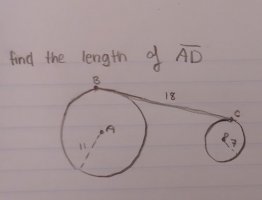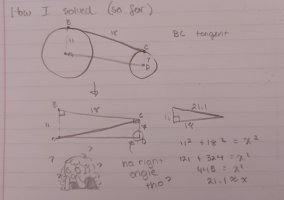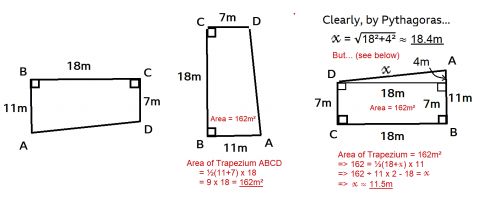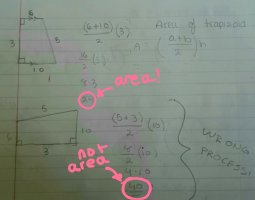Nunu
New member
- Joined
- Mar 31, 2022
- Messages
- 7
Hi everyone!
So I took a test today and I'm really confused on one of the problems...
What was on my test paper is attached to this post [there was not any additional information, which is why im confused, although the first page of the test did say "all lines that appear tangent, are tangent].
So far the method that I used [Second attachment] is that the tangent lines of each circle create right angles, and the shape that is made by connecting all the lines is a quadrilateral. I split the shape into two triangles, one of them has a right angle so I solved for the Hypotenuse of that using pythagorean theorum, but now I'm confused as to what to do, because I cant solve for the other triangle since its not a right triangle.
Again, the first attachment is what was on the test and the second attachment is what I did so far [I'm not sure if it's the right approach though!]
If anything is illegible, please lmk bc my handwriting isn't the neatest
Any help is appreciated, even if it's just a step that you think of, I'd love to hear it!
What was in the test:

What I did so far:

So I took a test today and I'm really confused on one of the problems...
What was on my test paper is attached to this post [there was not any additional information, which is why im confused, although the first page of the test did say "all lines that appear tangent, are tangent].
So far the method that I used [Second attachment] is that the tangent lines of each circle create right angles, and the shape that is made by connecting all the lines is a quadrilateral. I split the shape into two triangles, one of them has a right angle so I solved for the Hypotenuse of that using pythagorean theorum, but now I'm confused as to what to do, because I cant solve for the other triangle since its not a right triangle.
Again, the first attachment is what was on the test and the second attachment is what I did so far [I'm not sure if it's the right approach though!]
If anything is illegible, please lmk bc my handwriting isn't the neatest
Any help is appreciated, even if it's just a step that you think of, I'd love to hear it!
What was in the test:

What I did so far:



